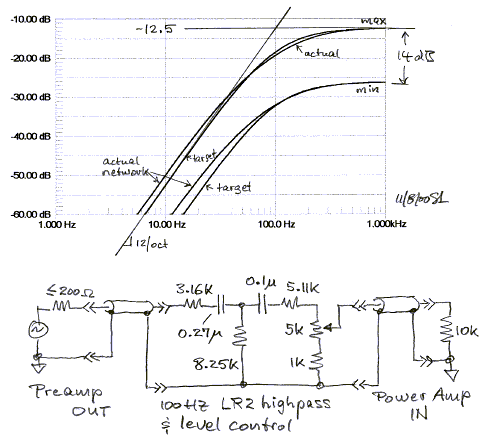or equations will do.
My goal is to come up with some passive pllxo circuits for a 4th order Linkwitz-Riley filter. I'd like to experiment with some different values before committing to a more permanent solution.
Any help is appreciated.
Dan
My goal is to come up with some passive pllxo circuits for a 4th order Linkwitz-Riley filter. I'd like to experiment with some different values before committing to a more permanent solution.
Any help is appreciated.
Dan
4th-order passive is almost impossible due to the impedance issue. Also you can't do Linkwitz-Riley with 4th-order, the Q will be 0.25 which is very droopy and probably quite poor for audio. You can only get Linkwitz-Riley in 2nd-order if you go passive, even that is difficult and would need a buffer and driver.
There is some good info at the below link, no calculator though.....
http://www.t-linespeakers.org/tech/filters/passiveHLxo.html
http://www.t-linespeakers.org/tech/filters/passiveHLxo.html
richie00boy said:4th-order passive is almost impossible due to the impedance issue. Also you can't do Linkwitz-Riley with 4th-order, the Q will be 0.25 which is very droopy and probably quite poor for audio. You can only get Linkwitz-Riley in 2nd-order if you go passive, even that is difficult and would need a buffer and driver.
Hhhmmmmm. Maybe someone should tell Marchand. ;-)
richie00boy said:Also you can't do Linkwitz-Riley with 4th-order
Hi,
Yes you can.
In fact the 4th order version is by far the original "famous" version,
(It is two cascaded or squared 2nd order Butterworth filters)
the 2nd order version becoming more popular and much abused
later, 2nd order electrical L/R is not L/R acoustic nearly always.
There is a L/R alignment for all even (2nd, 4th, 6th, 8th etc.) orders.
http://www.linkwitzlab.com/filters.htm
🙂/sreten.
See http://www.linkwitzlab.com/proto.htm for PLLXO examples.
without inductors you are limited to low Q second order.
most expensive speakers with selected component values stop at 3rd order due to the difficulty/expense of achieving the accuracy for 4th order.richie00boy said:4th-order passive is almost impossible due ......
First order is very tolerant of component values.
Second order requires some accuracy to achieve the desired roll off.
Third order requires much greater component value accuracy.
Unfortunately, the linkwitz lab link only shows the topic for active crossovers. I am looking for passive and line level.
Just recently I was looking into PLLXO's, and concluded that for a complex and/or higher order, one would have to go active. Input and output impedance, and insertion loss are the big problems here.
Dan_ed said:Unfortunately, the linkwitz lab link only shows the topic for active crossovers.
I am looking for passive and line level.

This may be useful : http://focus.ti.com/docs/toolsw/folders/print/tina-ti.html
🙂/sreten.
Thanks all.
The problem with most online calculators is that they are geared for filtering at the drivers, not at line-level. So they give rather screwy values. 🙂
I do have Micro-cap (a circuit simulator that runs on top of pspice) and some values for a 4th order LR at 250Hz or so. I suppose I'll start with that and iterate until I get the slopes and phases I want.
The problem with most online calculators is that they are geared for filtering at the drivers, not at line-level. So they give rather screwy values. 🙂
I do have Micro-cap (a circuit simulator that runs on top of pspice) and some values for a 4th order LR at 250Hz or so. I suppose I'll start with that and iterate until I get the slopes and phases I want.
OK I will re-qualify my statement. Without using inductors, 4th-order Linkwitz-Riley is impossible passive.
Reviving this thread in hopes of learning more about what you ended up doing Dan. Did you find a satisfactory solution?
Hi Dan -ed 😉 Yes , it's a very narrow topic but finally was given this link ... http://membres.lycos.fr/loutrenoel/ I 've had great results with 12dB/oct at 500Hz , with high grade ferrite cores (3H1 material) and 0,5% mil spec styroflex capacitors . I tried many others "active" before . 🙂 Pierre
- Status
- Not open for further replies.
- Home
- Design & Build
- Parts
- Looking for a line-level xover calculator